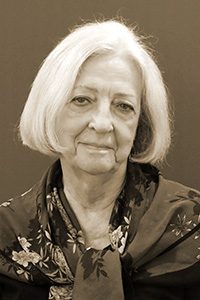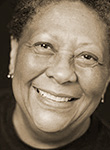Recommendations, Community, and Remembrance
Mary Flinn, Blackbird Founding Editor
Welcome to Blackbird’s In Previous Issues. Here we call your attention to work in our archives that for one reason or another has particular resonance against the work being newly published and/or the moment in which we are publishing. In addition, we will recognize work by old friends who are also current contributors and significant book-length material that we believe deserves steady and ongoing attention.
Last spring in Blackbird’s v20n1 issue, we noted that in many ways, that issue of Blackbird called attention to friendship. And after a second year of pandemic isolation, friendships seem exponentially more necessary even as they seem threatened by forces beyond our control. We also continue to notice what R.H.W. Dillard has called the “links and bobolinks” that materialize in our individual and communal lives.
Brian Henry stated in an essay on the subject in Blackbird’s v17n2 issue that: “I view translation as ‘a gesture of friendship through the word, an outcome and expression of camaraderie.’” In this issue, once again describing his process, he writes of the poems he has recently translated from Deception, a book his long-time friend Slovenian poet Tomaž Šalamun wrote while in Richmond:
Translating these poems felt especially poignant because I was constantly reminded of his tie here. As a translator, I have become accustomed to a certain level of emotional detachment from what I’m translating, even when the poet is a dear friend. I rely on my knowledge of them while translating, but in the end I am working with words on the page. Seeing my own name in a couple of these poems was something of a jolt to my usual perspective.
Henry’s translations of Šalamun’s work have appeared a number of times in past issues.
In Blackbird’s v20n1 issue, artist Elizabeth King’s essay “Eleanor Rufty: The Moment Between Moments” used her long familiarity with Rufty to illuminate the elusive mystery that is central to the artist’s recent paintings and drawings. We revisit Rufty in this issue with an informal conversation that touches on several of the paintings that King mentions in her essay. One of those paintings particularly depicts her friend Wesley Gibson in a visit to her studio. Gibson himself wrote a short appreciation of Rufty’s 1997 exhibition, “Voice Over.”
Gibson also wrote about Rufty’s late husband, artist Richard Carlyon, whose work first appeared in v1n1. In v4n2 Blackbird presented his paintings, drawings and videos as they appeared in a selective retrospective of his work at Richmond’s Reynolds Gallery, November 4–December 23, 2005. Carlyon and Rufty share a remarkable artistic accomplishment, each creating work that compels attention and reflection.
Gibson states of Carlyon:
I was once in Carlyon’s studio, and there were all these drawings lying around, pencil on beautiful paper. They appeared to be drawings of, perhaps, galaxies à la Vijay Celmins, and so I said, “What are these?” And Carlyon said, “They’re drawings of dust?” And I said, “How do you draw dust?” And he said, “You lay the paper out for a long time and you let the dust accumulate and then you draw whatever’s there.” Microcosm as macrocosm. The dust in the universe. The universe in the dust.
The late Gerald Donato, another valued member of VCU’s art community, appears here as the subject of a presentation by his wife Joan Gaustad that took place early this fall at VCU’s Cabell Library. The event marked the publication of Someone’s Missing . . . and I Think It’s Me: Our Great Adventure with Dementia, Gaustad’s graphic memoir about her husband’s early onset Alzheimer’s. The video of the presentation was produced by the Cabell Library. Blackbird previously published excerpts from “Gerald Donato: Reinventing the Game” the 2007 retrospective of his work, in v6n2.
Larry Palmer has previously appeared in Blackbird with “Urshel: The Beautiful Lost Sheep,” an excerpt from his memoir, Scholarship Boy, published in v15n1, with a reading from that memoir, published in v19n2, and with an additional essay addressing issues of race, “Call Me by My Name,” in v17n2. He continues to offer his observations on family and those persistent issues in a new essay, “On Learning to Love the Sea.”
~
Serial Publications in Blackbird
Blackbird has published two full-length books in our pages and is in the process of publishing two more.
Early on, Blackbird presented the entirety of Norman Dubie’s The Spirit Tablets at Goa Lake, a book-length futurist poem. The poem was issued serially in three parts, beginning with the “Book of the Jewel Worm” in v1n2. It was followed by the other two sections, “Book of the Jaspers” and “The Book of Crying Kanglings,” in v2n1 and v2n2, as well as a helpful introduction and glossary. As Dubie states in a note to the piece,
This futurist poem enjoys the broken narration of its hero, Paul Ekajati, an amateur mathematician who once taught the Calculus on our moon. He is now an exhausted buddhist Vajramaster living in a small village at the Bakavi Lake Mining Colony on Mars. The year is 2277. Yeshe Khandro is in her last black ovum. Or, I should say that a raised mischievous voice in the poem belongs to a dakini “wisdom traveler in space” and that she is the destroyer of the Vega Remnant, LXT. There are eleven spirit tablets.
Nobel Prize–winning author Tomas Tranströmer’s 1996 book Sorgegond olen (Sorrow Gondola), in a new translation by Patty Crane and accompanied by the original Swedish, was published in Blackbird v10n1. To accompany the new translation Jean Valentine provided a letter to the Nobel laureate and David Wojahn presented a compelling meditation on literary friendship and correspondence in “Unlikely Magic, (on Airmail: The Letters of Robert Bly and Tomas Tranströmer).” There, Wojahn states, “The great subject of the poetry of Tomas Tranströmer—sometimes it seems as though it is his only subject—is liminality. He is a poet almost helplessly drawn to enter and inhabit those in-between states that form the borderlines between waking and sleeping, the conscious and the unconscious, ecstasy and terror, the public self and the interior self. Again and again his poems allude to border checkpoints, boundaries, crossroads: they teeter upon thresholds of every sort—be they the brink of sleep or the brink of death, a door about to open or a door about to close.” In v19n1, Blackbird published six new Crane translations of Tranströmer poems.
Since Wesley Gibson’s death in December 2016, Blackbird has contemplated ways to ensure his literary voice maintains a presence in the world. With that end in mind, we are in the process of reproducing his book, You Are Here: A Memoir of Arrival, which was published in 2004 by Back Bay Books. The book, in part, is an account of Gibson’s witness to the HIV/AIDS crisis and its effects in New York City. Hailed at the time by Mary Gaitskill as “dark and sparkling, wonderfully intelligent, flip, and deeply felt,” You Are Here affords an excellent vehicle for honoring Gibson’s many strengths as a writer and his generosity of spirit as a friend. The first installment appeared in v17n1, with the next four appearing in v18n1, v18n2, v19n1, v19n2, v20n1 and v20n2. A review of You are Here and a reading by Gibson were published in v3n1. His story, “The Raccoon,” appeared in v10n2.
Marilyn Nelson has for many years celebrated her friendship with Danish writer Inge Pedersen by translating her work, thus making it more available to the Anglophone world. Nelson’s translations of poems from Pedersen’s Den trettende måned appeared in Blackbird v1n1. Her translation of “Clouds and Fire Engines,” an excerpt from Pedersen’s last novel, The Path Leads through the Air, appeared in v18n1, followed by “The Apple” in v18n2, “Seedings” in v19n1, “Mail” in v19n2, and “That’s How It Goes Here” in v20n1. In this issue, Blackbird continues the story with “Putting a Letter in the Mailbox.” Nelson herself is the author and translator of more than twenty books of poetry for both children and adults. ![]()










